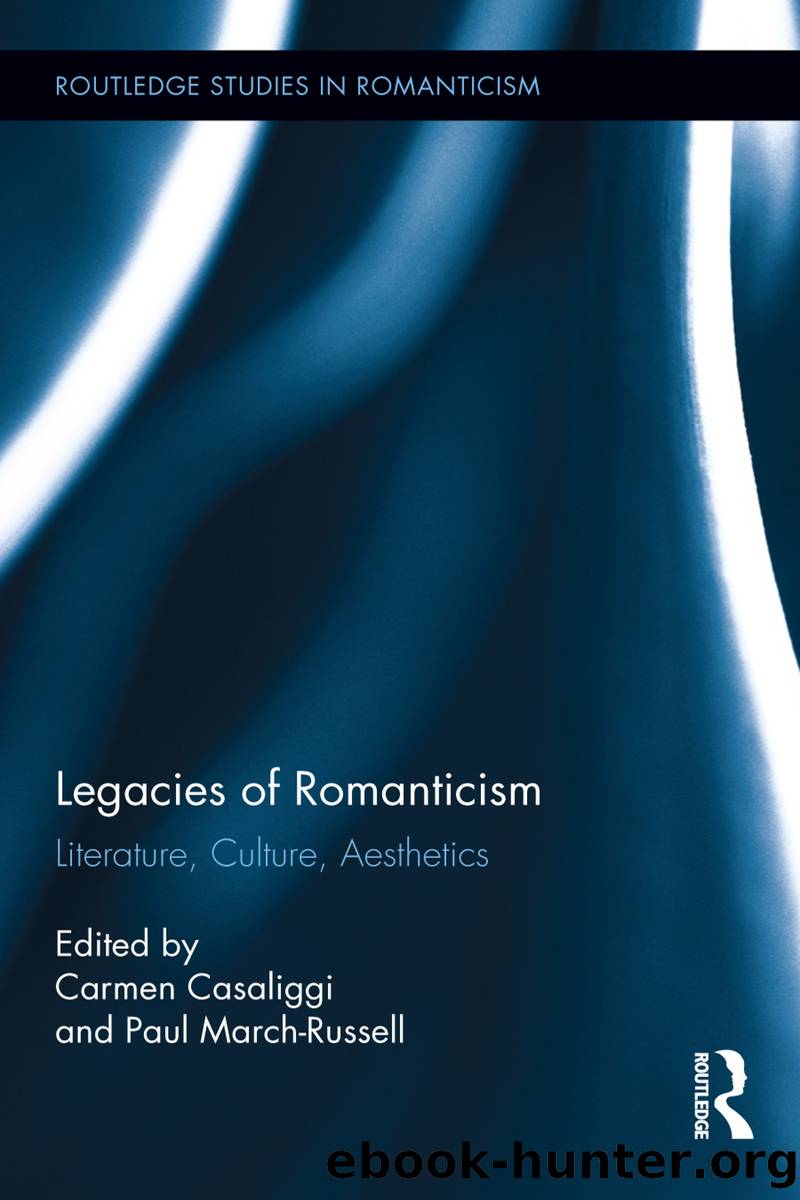Legacies of Romanticism by Casaliggi Carmen;March-Russell Paul;

Author:Casaliggi, Carmen;March-Russell, Paul;
Language: eng
Format: epub
Publisher: Taylor & Francis Group
Published: 2012-08-15T00:00:00+00:00
A year before I read Eliot my favourite long poem was Prometheus Unbound but this had already cloyed; Shelleyâs enthusiasms were beginning to seem naïve to a child of the Twentieth Century, even to a child who had only fleeting contacts with its over-industrialized, over-commercialized, over-urbanized, over-standardized, over specialized nuclei. What we wanted was ârealismâ butâso the paradox goes onâwe wanted it for romantic reasons. 6
MacNeiceâs reminiscence about the nature of his formative poetic preoccupations suggests the paradoxical poetic drives in his work, where the ârealistâ and the âRomanticâ function as opposite poles. Both exist within his work, despite MacNeiceâs wish to purge his work of the âromantic reasonsâ for the existence of ârealismâ. Like W.B. Yeats, on whom MacNeice had written a challenging although approving study, MacNeice seems determined to distance himself from Shelleyâs seductive, though dangerous, example by seeing his work as betraying a naïve meliorism. 7 Yet Shelleyâs preoccupation with fissures, irony, and sceptical vision suggest a far more sophisticated form of poetic optimism than MacNeiceâs remark would allow; as P.M.S. Dawson writes: âIn only one of Shelleyâs works can he be called a Utopian, and that is Queen Mab, which has been described as Godwin in verse, quite wrongly for it is really the least Godwinian of all Shelleyâs major worksâ. 8 Owing to Shelleyâs profound social engagement, the problem of creating a poem that can steer between the Scylla of simplistic optimism and the Charybdis of unrelenting pessimism became a major poetic concern for Shelley as he sought to explore reality without diminishing the claims of the human potential.
Richard Danson Brown characterises MacNeice in the thirties as âa young poet struggling between conflicting priorities and potential voicesâ. 9 Shelleyâs balancing act between two strong personalities in Julian and Maddalo offered him an example of the opportunities open to the self-divided poet. MacNeice, like Shelley and Byron, 10 remained âbruised by exileâ; he refused the Marxist politics of his contemporaries, and failed to assimilate fully into either English or Irish culture. 11 MacNeice suggests this schism in âPostscript to Icelandâ as he, like Shelley, sketches a subtle division between the two poles of the self. Rather than rehearsing Shelleyâs debate between optimism and pessimism, MacNeice balances a Don Juan-like witty and urbane speaker against a gloomily experienced Maddalo-like voice. Less loquacious than Auden in identifying himself explicitly with Byron, MacNeice found in him a similarly significant influence. 12
Both MacNeice and Auden make a bid for Byronic sensibility, although MacNeiceâs understanding of the Byronic differs fundamentally from the levity of tone that Auden claims as the legacy of Byronâs poetry. 13 âCock oâ the Northâ (1950â51) pays homage to a Byron undetectable in Audenâs witty and arch âLetter to Lord Byronâ (1937) as MacNeice adopts Byronâs voice to hail him for his ethical strength, writing: âI will hae the courage oâ my fear / And blaze a path to silenceâ (CP 326). Viewing Byron as a serious defender of Greece as well as a poet, who can
Download
This site does not store any files on its server. We only index and link to content provided by other sites. Please contact the content providers to delete copyright contents if any and email us, we'll remove relevant links or contents immediately.
The Power of Myth by Joseph Campbell & Bill Moyers(936)
Half Moon Bay by Jonathan Kellerman & Jesse Kellerman(920)
A Social History of the Media by Peter Burke & Peter Burke(886)
Inseparable by Emma Donoghue(853)
The Nets of Modernism: Henry James, Virginia Woolf, James Joyce, and Sigmund Freud by Maud Ellmann(772)
The Spike by Mark Humphries;(730)
A Theory of Narrative Drawing by Simon Grennan(712)
The Complete Correspondence 1928-1940 by Theodor W. Adorno & Walter Benjamin(711)
Ideology by Eagleton Terry;(665)
Bodies from the Library 3 by Tony Medawar(656)
World Philology by(649)
Culture by Terry Eagleton(648)
Farnsworth's Classical English Rhetoric by Ward Farnsworth(647)
Adam Smith by Jonathan Conlin(618)
A Reader’s Companion to J. D. Salinger’s The Catcher in the Rye by Peter Beidler(616)
Game of Thrones and Philosophy by William Irwin(604)
High Albania by M. Edith Durham(598)
Comic Genius: Portraits of Funny People by(588)
Monkey King by Wu Cheng'en(581)
